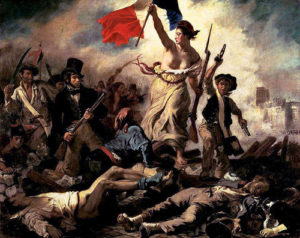Authority might suppress individual rights and wants, while individual liberty might lead to internal conflicts within the society or sub-optimal collective growth.
Libertarian Paternalism and Dharma

Liberty and Authority: The struggle
John Mill said,
The struggle between Liberty and Authority is the most conspicuous feature in portions of history”.
Authority might suppress individual rights and wants, while individual liberty might lead to internal conflicts within the society or sub-optimal collective growth. When there is higher-order planning and instruction in society, there is a higher chance of coordination if done carefully within the various elements of the community. However, that might not translate directly to individual happiness as people might need to sacrifice their desires involuntarily. On the other side of the spectrum, higher individual freedom might lead to a conflict of interests within the society as people might want to fulfil their desires at the cost of another knowingly or unknowingly. Is there a way out of this unceasing struggle between Liberty and Authority? This article delves into the toolkit of Behavioural Economics to provide a solution to this conflict.

Mill recognized this conflict when he said, “pursuing our own good in our own way so long as we don’t attempt to deprive others”. This statement suggests that he recognized that individual freedom might lead to suppression of other’s freedom. Therefore, he proposed that there must be a minimum authority. The role of minimum authority would be to prevent harm caused by a group to another while pursuing freedom. This theoretically looks like a promising solution. However, while considering its practicality, it might look fuzzy.
The challenge in Mill’s suggestion is to qualify what harm means. In the 18th chapter 48th verse of Srimad Bhagavad Gita, Shri Krishna states that no work is free from defect, just as fire naturally has smoke on top of it. For example, the very act of breathing kills microbes environing one. Therefore, every action has both a valuable and harmful face to it, and there is no perceivable boundary that distinguishes the beneficial from the harmful side. According to Mill’s suggestion, if one considers the dangerous side of action and tries to prevent that, one becomes authoritative. In contrast, if one just finds the beneficial part of an action and supports it, one becomes liberal. Therefore, both authoritative and liberal stands can be corroborated and protested at the same time. Thus, there is an eternal conflict between the supporters of these dual groups.
Many-sidedness in Indian Logic
Indic philosophical concepts such as ‘Anekantavad’ recognizes that challenges cannot be countered from one-sided perspectives. Thus, when modern philosophy considers logic from just a one-sided view of ‘True’ and ‘Not True’, Indian philosophy has classified logic into a multi-sided view of ‘True’, ‘Not True’, ‘Both True and Not True’ and ‘Neither True nor Not True’. Therefore, in the linear frame of reference, just either an authoritative or a liberal proposition could be adopted. However, with Indic logic, the concepts that seem to be oxymorons are often accepted as the fundamental realities of life. To provide one example, consider the idea of Nishkam Karma. According to Indian philosophy, there could be action in inaction and inaction in action. In fact, ingraining such concepts in life leads one to higher states of being.

Such a seeming oxymoron in the context of our discussion was provided by Richard Thaler and Cass Sunstein. They contributed the term Libertarian Paternalism. Their emphasis is on the fact that “in many domains, people lack clear, stable, or well-ordered preferences.” They also emphasize the possibility that “in some cases, individuals make inferior decisions in terms of their own welfare- decisions that they would change if they had complete information, unlimited cognitive abilities, and no lack of self-control.” The paternalistic aspect of this philosophy argues for “self-conscious efforts by private and public institutions to steer people’s choices in directions that will improve the choosers’ own welfare.” The libertarian aspect of this philosophy argues for “people to be free to opt out of specified arrangements if they choose to do so.”

The case for Libertarian Paternalism
Some people oppose paternalism, claiming it to be authoritative. Thaler and Sunstein argue that there is no alternative but for actions to be paternalistic. Giving the example of a cafeteria, they demonstrate how being paternalistic is the best option possible. They say that a cafeteria can make strategy choices of presenting the order of the menu in different ways. The research suggests that those items shown above have higher chances of being selected by customers. The various strategies for deciding items to be placed above are-
- Make the customers best off considering all things.
- Make choices randomly.
- Make choices that make the customers as obese as possible/ reap maximum benefit from the customers.
- Provide customers what one thinks they would choose on their own.
They claim that option 2 and option 3 would not be preferred by concerned people over option 1. Like Indian philosophy, wherein the act of doing no action is also an action, Thaler and Sunstein claim that when even the random choice will influence the customers, why not optimize it? Now, there could be multiple ways to optimize the presentation of the menu. One way would be option 3, where optimization could reap maximum personal benefits or make other worse off. There is no doubt that decisions could be taken with selfish motives. Still, since the customers have the liberty of conceiving the whole menu, libertarian paternalism is the best resistance to selfish motives. However, for the Dharmic or concerned people, option 3 would not be appealing. Between option 1 and option 4, an anti-paternalist would opt for the latter. However, as claimed by Thaler and Sunstein, it isn’t easy to implement. First of all, it isn’t easy to know the true preferences of others. Secondly and importantly, most of the time, research suggests well-formed preferences don’t even exist for people. The preferences are subject to environmental conditions such as the order of presentation in the menu, and thus, they are not intrinsically consistent. Thus, the best option to opt for the cafeteria would be option 1.
Till now, the conventional economics theory considered that the preferences are well-formed and consistent. However, the advent of Behavioural economics challenged this normal. Behavioural economics concepts such as framing, priming and anchoring suggest how the environment can be a substantial decisive factor in people’s behaviour. The framing effect states that consumer decision depends on how information is presented. Priming occurs when exposure to something alters behavioural patterns. Anchoring is the skew towards the initial benchmark value.
Dharma: Ingredient to make Libertarian Paternalism inclusive
A prominent application of behavioural economics would be to nudge people towards being Dharmic. Nudge means to touch or push gently. In the behavioural economics domain, nudge, as defined by Thaler and Sunstein, “is any aspect of the choice architecture that alters people’s behaviour in a predictable way without forbidding any options or significantly changing their economic incentives. To count as a mere nudge, the intervention must be easy and cheap to avoid. Nudges are not mandates. Putting fruit at eye level counts as a nudge. Banning junk food does not.” Since it is known that the preferences are not well-formed and since we have also seen people who have transcended the boundaries of their limited identity to work for the overall welfare of society, it would be fascinating to research what nudges prompt people towards being their higher compassionate self.

In every great being’s life, experiences have taught them to become what they became. Everybody passes through a myriad of experiences in their life, but wise people take apt feedback from these experiences and learn from them. In one way of perception, everything one has gathered is from society. Not just the body is collected from the earth, the knowledge is also gathered from parents, teachers, gurus, authors and various contributors in one’s lifetime. Therefore, the role of the environment increases manifold in determining how a society flourishes. Thaler and Sunstein describe that the environment can be crafted to nudge people towards their welfare. They termed this crafting of surrounding as choice architecture.
The Dharmic philosophy adds to this and shows that individual welfare is not distinct from societal welfare. The choice architecture for the society’s welfare is nothing but the culture. Dharma, as we understand it, is intrinsic and not extrinsically motivated. Acts that are performed due to outside force could not be classified as dharmic acts. Therefore, an authoritative mode for driving the society will not lead to the establishment of a dharmic society. At the same time, people need a guiding force that prompts them towards dharma. In those cases, dharmic leaders that have gathered shraddha of the masses can steer. But, such leaders are few and have not reached everywhere at a personal level. However, systems are ubiquitous and touching each one’s life in varied ways. Therefore, it is crucial to design choice architectures with dharmic nudges based on libertarian paternalism. The application of these concepts is infinite, and there is a lot of scope for creativity. Therefore, a lot of research needs to happen on designing dharmic nudges for the Bharatiya context.
References:
– Mill, J. S. (1975). On liberty (1859).
– https://www.holy-bhagavad-gita.org/chapter/18/verse/48
– http://indiafacts.org/chatuskoti-four-sided-negation/
– Sunstein, C. R., & Thaler, R. H. (2003). Libertarian paternalism is not an oxymoron. The University of Chicago Law Review, 1159-1202.
– Thaler, R. H., & Sunstein, C. R. (2003). Libertarian paternalism. American economic review, 93(2), 175-179.
– Thaler, R. H., & Sunstein, C. R. (2009). Nudge: improving decisions about health, wealth, and happiness. Rev. and expanded ed. New York: Penguin Books.
– Kahneman, D. (2011). Thinking, fast and slow. Macmillan.
Images:
2: https://travel2photograph.files.wordpress.com/2011/02/tibetan-wheel-of-live.jpg?w=584
3: https://blogimage.vantagecircle.com/vcblogimages/2021/07/Nudge-Theory-featured-image.png
4: https://upload.wikimedia.org/wikipedia/commons/thumb/d/df/Dharma_Wheel.svg/600px-Dharma_Wheel.svg.png

Leave a Reply